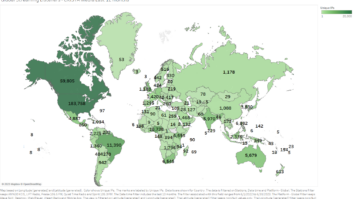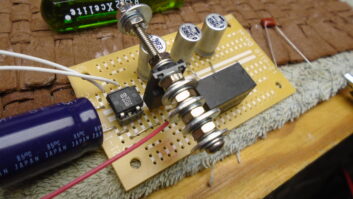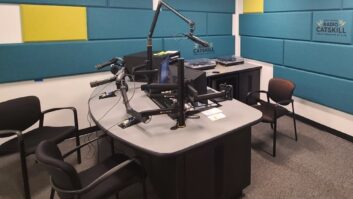Sending audio was never this easy
Apr 1, 2003 12:00 PM, By Chriss Scherer, editor
With digital technology comes the necessity to encode and decode audio for the medium that will carry it. The process of manipulating bits is used in almost every form of digital delivery. The term codec is now widely used in circles well beyond radio and broadcasting. While downloading and installing a specific software codec is second nature for most computerized media users, the term codec still carries a singular meaning for radio broadcasters.

Telephone service has a long history with radio. It was frequently used for point-to-point audio distribution because of its simplicity. Even with the telephone’s limited audio bandwidth, it was a popular method of transmission. To improve the response of the telephone line, heroic efforts were successfully made with frequency extenders. While these improved the quality, they still fell short of providing an easy-to-use method of establishing a high-quality link.
When the telephone companies began making high-speed services available to consumers, it didn’t take long for broadcasters to combine the telephone flexibility with the newly developed methods of digital audio data compression. When Switched 56 and ISDN became available in most areas, telephone codecs became more and more popular.
The ISDN codec changed the way radio stations held remote broadcasts. No more fooling around with remote pickup transmitters, licenses and interference; just order an ISDN line and send a remote kit.
As digital audio data reduction techniques improved, the methods were applied to the more universal telephone service�the POTS line. Now both versions see widespread use every day. Their use has even extended beyond wired uses to some wireless applications.
What�s in a name? While most tech-savvy radio people are familiar with the terms POTS and ISDN, here�s a quick refresher.
POTS – Plain old telephone service. The traditional telephone service capable of 300Hz to 3kHz of analog audio transmission. Not a fancy acronym, but it is accurate.
ISDN – Integrated services digital network. Simply put, a digital telephone line capable of transmitting at least 64kb/s. At one time it was imagined that ISDN service would replace all POTS lines. This never happened.happened.
F or more on the various interfaces used with codecs, see the sidebar called What’s in an Interface? by clicking this link.
Deciding which to use
Many stations use ISDN and POTS codecs regularly. When using an MPEG algorithm, and ISDN codec will always provide the widest frequency range. If all other factors are equal, ISDN will usually win.
ISDN also provides consistent performance. Data and digital circuits from the telephone provider are designed for reliability. Once a connection is made, it will stay in place with fewer problems. ISDN also has some disadvantages. It is more complicated to set up. Some telephone companies require long lead times to install service, ranging from 30 to 60 days. In some instances, ISDN may not be available in a given location. There are also variations in the types of ISDN. Ordering the proper configuration can be frustrating, but all the ISDN codec manufacturers offer advice and hints to make the ordering easier.
Depending on the codec hardware, setting up the ISDN codec may be more complicated than setting up a POTS codec.
The cost to install and use an ISDN circuit is typically more than the same costs for a POTS line. ISDN is usually billed a monthly rate plus time usage, whereas POTS lines are usually just a monthly rate. For business customers, the monthly rates for an ISDN line and a POTS line are similar, but POTS is usually cheaper.
The biggest advantage for POTS codecs is the proliferation of POTS lines. Last-minute remotes can usually be accommodated easily. It’s usually easy to borrow a fax line or modem line for the broadcast. In a pinch and with the proper connection, the POTS codec can be used through a PBX telephone system. The connection rate will usually suffer, but the broadcast will be on the air.
The main drawback to using a POTS codec is that the audio performance depends on the quality of the connection.
If you routinely have trouble with a POTS line, there are several steps you can take to improve the performance. You will need to work with your telephone company to do this. Don’t simply open a trouble ticket stating that the data rate is too low. Most of the time, the ticket will be opened and closed almost immediately because your reported problem won’t go through the scrutiny it deserves. The telephone company test will show an adequate noise level and loading. Instead, try contacting a customer service representative directly to discuss the problem. By making the telephone company aware of your problem through the circumstances, you should be able to improve the service.
The distance from the user’s connection to the telephone central office (CO) is the first limiting factor. While you can’t change the location of either of these places, it may be possible to obtain service from a different CO. The longer the distance, the less reliable the line will be.
Comrex has introduced a GSM wireless module that simplifies accessing the wireless network with a codec.

Find out if the telephone line is carried through a subscriber line concentrator (SLIC). If it is, ask to be removed from the SLIC and put on direct copper lines. A subscriber line concentrator is commonly installed to serve pockets of high population density that are physically distant from the central office. New construction areas are commonly connected through a SLIC. The SLIC allows more calls to be carried in a smaller capacity. While this is advantageous to the telephone company, using a SLIC adds an additional conversion step to the path, which is not good for POTS codecs.
Once the physical path from the phone to the CO is a direct copper connection, have the telephone company check the line for loading coils. If any are found, have them removed. The loading coils are passive repeaters. Once the coils are removed, take the time to find the copper pair with the lowest noise. This may take some time, but the reward is worth it.
Finally, be sure that any bridge taps are removed from the line. Bridge taps are split connections that run to other destinations. In most cases, these are left behind from a previous installation and use of the wire pair. A bridge taps add capacitance to the line and can be a receiver for induced noise.
Earlier I mentioned that a POTS codec should not be used with a PBX. If an analog port is available, the codec will work, but the circuitry in the PBX will likely cause a performance reduction. Also, because electronic phone systems use standard RJ-11 jacks, don’t assume that the connection you are given is a POTS line. There are commercial phone testers that will indicate the personality of a telephone line. If you don’t have one, a cheap alternative is an inexpensive phone. Many electronic phone systems have voltages and currents that are different from those on a regular phone line. The voltage present can destroy the modem in the POTS codec. If you plug the analog phone in and can get a dial tone, you are probably OK to use the POTS codec.
ISDN codecs have evolved to serve in applications beyond the telephone connection. IP and streaming connectivity are becoming standard uses.

ISDN ordering
Ordering a POTS line is easy. There are only a few decisions to make, most of which have nothing to do with the actual service.
ISDN is available in two basic varieties. The Basic Rate Interface (BRI) has one or two bearer channels (at 64kb/s) and one data channel (at 16kb/s). The other variety is the Primary Rate Interface (PRI), which provides 23 bearer channels and one data channel. When ordering an ISDN line for use with a codec, specify BRI service.
Several options will be presented, but cut to the chase and specify that you want a U-interface reference point, 2B1Q line coding and either 2B+D service, which supports up to 128kb/s, or 1B+D service, which supports up to 64kb/s. Most rack-mount codecs are designed for 2B+D service.
Once the line is ordered, be sure to get the following information from the telephone company:
- The type of switch that the line will use
- The ISDN switch protocol version
- The ISDN telephone numbers, called local dialing numbers (LDN)
- The SPIDs with the prefixes and suffixes
ISDN service may be offered as point-to-point or point-to-multipoint. In most cases, point-to-multipoint service is preferred. This allows the user to dial and receive calls from two separate codecs simultaneously. While this is not a requirement of ISDN service, it does provide extra flexibility. For instance, a single program can be sent to two destinations. A small network can be created on the fly as needed.
In addition to BRI ISDN, other data networks may be used with an audio codec. One example is Frame Relay. This does not have the flexibility of dialing an ISDN number, but excess capacity on an existing circuit can be used for audio information.
Wireless options
The wired codec options have created opportunities to originate broadcasts from unique locations, but their nature requires that a wired service be available. Ignoring the required lead time to order a telephone circuit, the physical tie to the CO has been a limitation for some. This is one area where RPU transmitters continue to reign.
Simplicity and convenience are key features for portable codecs. Internal mixers and multiple connections add to a system’s capability.

The proliferation of wireless services has made mobile reporting easy, although the audio quality of most services is far from optimal. In most cases it’s barely acceptable.
As wireless telephony has improved, adapting the service to codec use as a wireless data path has garnered attention. Until recently, cell service did not have the capacity or robustness to handle a high quality, encoded audio data stream. In 1993, the Personal Communications Service (PCS) was launched in the United States. This encompassed three types of technology.
Time Division Multiple Access (TDMA), which is being phased out, was developed to take advantage of the existing analog infrastructure. Code Division Multiple Access (CDMA) is primarily used by Sprint and some regional carriers. Both of these cannot reliably carry the audio data needed for a broadcast.
The Global System for Mobile Communications (GSM) was developed in Europe and has become the predominant wireless telephone technology outside North America. GSM service availability is increasing, thanks to T-Mobile and Cingular.
GSM is a modified, more efficient version of TDMA and uses time slots and frequency channels to allocate the spectrum in use. GSM data rates start at 300b/s. Calls use as many time slots as necessary up to a maximum usage of 13kb/s. Calls will jump between channels and time slots (frequency hopping) to maximize the system’s usage.
Rack-mount studio chasis units that house multiple codecs are ideal for stations that rely on high-volume codec connectivity.

POTS codecs, designed for low data rates, are an ideal choice to tap into the portability of GSM phones. We are currently on the cusp of seeing this application take off.
Another wireless codec application that is useful in areas where GSM service does not exist is satellite phones. These phones, which are a necessity in some parts of the world, provide service from the United States mostly in coastal waters. While airtime is fairly expensive and the portable terminal must be licensed by the FCC for use on land, certain circumstances, particulary a mobile environment, may justify its use.
Cheap insurance
Codecs have proven to be a highly flexible and convenient method of sending duplex audio. Stations regularly use them for remote broadcasts because of their ease of use and quality sound. Even in fixed locations that need a connection on a daily or weekly basis, a codec makes perfect sense.
Telos has introduced the Xport, which can use a POTS line in the field to call an ISDN codec at the studio.

If the codec you have chosen can operate on ac power or batteries, install a set of batteries even if ac power is used. If ac power is lost, the battery power can keep you on the air to cover the outage. Most codecs that operate on batteries will do so for at least an hour.
Most transmitter sites have a POTS line available for regular use or for a dial-up remote control. This line can also be used with a POTS codec as a backup STL if needed. If a higher quality backup is needed, install an ISDN line at the transmitter. Even if an ISDN codec is not permanently installed, the line will be available when it is needed.
Codecs have made their mark and continue to show their flexibility with new applications. The technology originally designed for use on data-restricted, dedicated circuits has made its way into other uses including wireless telephony and audio data multiplexing and streaming.
Thanks to Comrex and Telos for providing information.
Resource Guide
For a complete feature comparison of these products click here for a PDF.
Swing
ISDN
Eagle
ISDN
Course
ISDN
Millennium 2
ISDN
Scoop Reporter E-Z
ISDN, POTS, wireless
Scoop Studio
ISDN, POTS
HIFIScoop 3
ISDN
Communicator
ISDN, IP
WorldNet Milano
ISDN
WorldNet Rio
ISDN w/TA
Worldnet Tokyo
ISDN
Vector
POTS
Matrix
ISDN, POTS, Wireless
Matrix Rack
ISDN, POTS, Wireless
Envoy
ISDN
Nexus
ISDN
Nexus Rack
ISDN
BlueBox
POTS, Wireless
Intralink ISDN Muliplexers
ISDN, IP
CDQ1000
ISDN
CDQPrima 110
ISDN
CDQPrima 120
ISDN
CDQPrima 210
ISDN
CDQPrima 220
ISDN
CDQPrima 230
ISDN
Liberty
POTS
Netstar
ISDN, IP
Prima LT
ISDN
Prima LT Plus
ISDN
RoadRunner
ISDN
SuperLink
ISDN, IP
TEAM
ISDN, IP
Opticodec 7000
ISDN
Opticodec 7400
ISDN, IP
Nica X-1
ISDN
Nica X-2
ISDN
Zephyr Xstream
ISDN, IP
Zephyr Xstream MX, MXP
ISDN, IP
Zephyr Xport POTS
POTS
Zephyr Xport POTS & ISDN
ISDN, POTS, IP
Imix
POTS, ISDN, wireless
Commander
POTS, ISDN, wireless
Patriot
POTS, wireless












